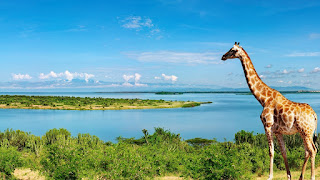ZUULA FACTS OF RIVER NILE UGANDA
Zuula Nile River Facts
Lake
Victoria, , is generally known as the
source of the River Nile. On the northern edge of this lake, water pours over a
waterfall, known as the Ripon Falls; into a narrow opening which many people
believe is the beginning of the River Nile. Ripon Falls is the starting-point
of the water, Lake Victoria is
surrounded by mountains with streams tumbling on to the lake. The largest
tributary of Lake Victoria is the River Kagera. The Kagera River and its
tributary the Ruvubu, having its headwaters in Burundi, is now accepted as the
true source of the River Nile. It is from here where the River Nile is measured
as the world’s longest river.
The Nile River, considered the longest river in the
world, is approximately 4,258 miles (6,853 kilometers) long, but its exact
length is a matter of debate. Flowing northward through the tropical climate of
eastern Africa and into the Mediterranean Sea, the river passes through 11
countries: Tanzania, Uganda, Rwanda, Burundi, the Democratic Republic of the
Congo, Kenya, Ethiopia, Eritrea, South Sudan, Sudan and Egypt.
The Nile has two major tributaries: the longer
White Nile, considered the prime stream and headwaters; and the Blue Nile,
which carries about two-thirds of the river's water volume and most of the
silt.
The White Nile begins at Lake Victoria, Africa's
largest lake, which touches the countries of Uganda, Kenya and Tanzania. But
Lake Victoria isn't necessarily the most distant and "true" source of
the Nile River because the lake itself has many feeder rivers coming in from
the surrounding mountains. In 2006, a British explorer named Neil McGrigor said
he'd traveled to the Nile's most distant source at the beginning of the Kagera
River, Lake Victoria's longest feeder river.
§
The
River Nile is formed from the ‘White Nile’, which originates at Lake Victoria
and also the Blue Nile, which originates at Lake Tana inside Ethiopia. These
rivers meet in Sudan and then go on their long journey northwards for the sea.
§
The
White Nile is a lot bigger than the Azure Nile, but because of losses on the
way it contributes only about 15% for the flow of the combined Nile. Whereas
the Blue Nile, rising in Ethiopia, contributes about 85% to the flow of the
Nile River that passes through Egypt to the Mediterranean.
Because
it offered water, food, transportation and excellent soil for growing tasty
food most Egyptians lived near the Nile
§
The
Nile River flows into the Mediterranean Sea.
§
The
largest supply of the Nile is the Victoria Lake.
§
The
Nile includes a length of about 4, 160 miles or 6, 695 kilometers.
§
Nile
River’s average discharge is 680, 000 gallons (3.1 mil liters) each second.
§
The
Nile basin is huge and includes aspects of Rwanda, Burundi, Tanzania, Kenya and
Congo (Kinshasa).
§
The
name Nile originates from the Greek word “neilos”, which means river.
§
It
does not take the place of the longest river in the globe. It is approximately
6, 670 km (5, 160 miles) long.
§
The
river average floods is approximately 300 million cubic meters per day.
§
There
are nine countries the Nile and tributaries flow through. These countries are
Egypt, Ethiopia, Tanzanian, Uganda, Kenya, Burundi, Sudan, Rwanda and Zaire.
§
Many
parts on the Niles banks are full of Crocodiles. They are the biggest
crocodiles in Africa.
§
Major
dams built within the Nile River include the High Aswan Dam, Roseires Dam,
Sennar Dam and Owen Falls Dam.
§
The
Nile basin (the land area drained because of the river) is very big. It
includes areas like Congo, Tanzania, Burundi, Kenya, and Rwanda.
The Nile Delta is 100 miles long and 150 miles wide.
Credit: NASA
The Nile Delta
The
Nile waters flow at an average volume of 300 million cubic meters (79.2 billion
gallons) per day, according to Travelling
Along Rivers, a Dutch bilingual travel magazine. It takes approximately three months
for the waters near the town of Jinja, Uganda (the point where the Nile leaves
Lake Victoria), to reach the Mediterranean Sea.
The Nile Delta is approximately 100 miles (161 km)
long from north to south, and it spreads out along about 150 miles (241 km) of
Egyptian coastline, from Alexandria in the west to Port Said in the east. It is
one of the world's largest river deltas with about 40 million inhabitants —
approximately half of Egypt's population. Just before reaching the
Mediterranean Sea, the river splits into two main branches, the Rosetta Branch
(to the west) and the Damietta (to the east).
Wildlife
The Nile River and its banks are abundant with many
varieties of animal life. These include the rhinoceros, African Tigerfish (the
"piranha of Africa"), Nile monitors, enormous Vundu catfish,
hippopotamuses, wildebeests, baboons, frogs, mongooses, turtles, tortoises and
over 300 species of birds. Hundreds of thousands of water birds spend their
winters in the Nile Delta. This includes the world's largest concentrations of
little gulls and whiskered terns.
Possibly the most well-known animal — and most feared — is the Nile
crocodile. This fearsome predator has a reputation as a man eater and rightly
so. Nile crocodiles can reach lengths of 18 to 20 feet, and unlike their
American cousins, can be quite aggressive toward people. Estimates say that
about 200 people a year are killed by these reptiles, according to 



Comments
Post a Comment